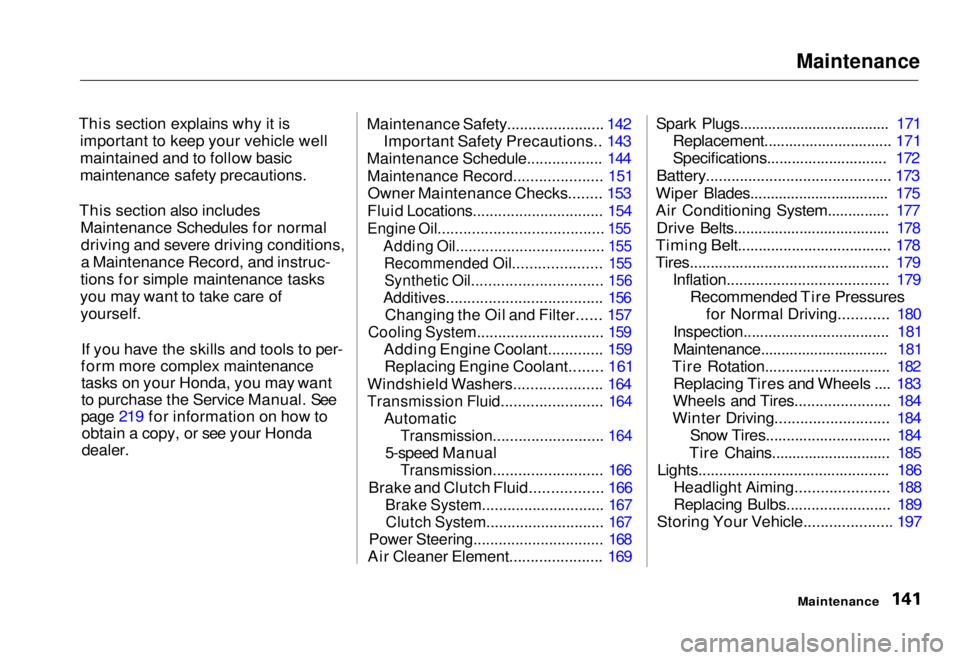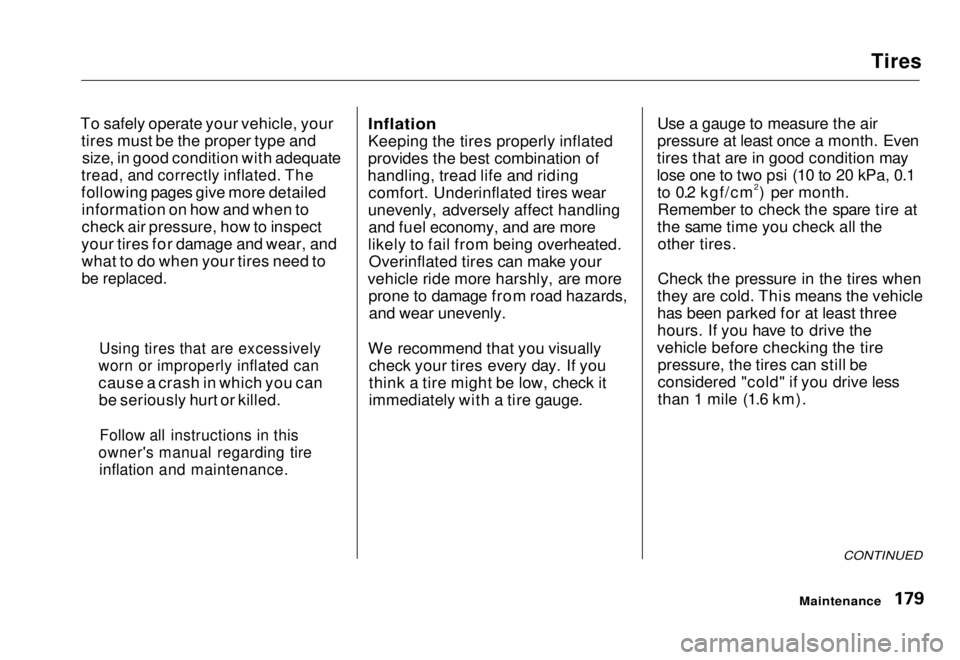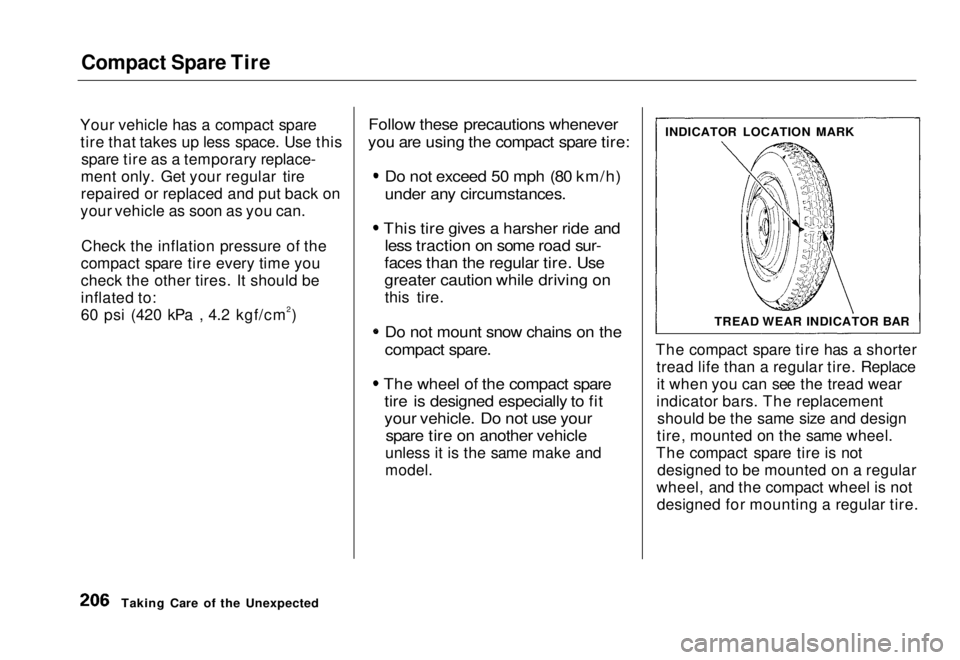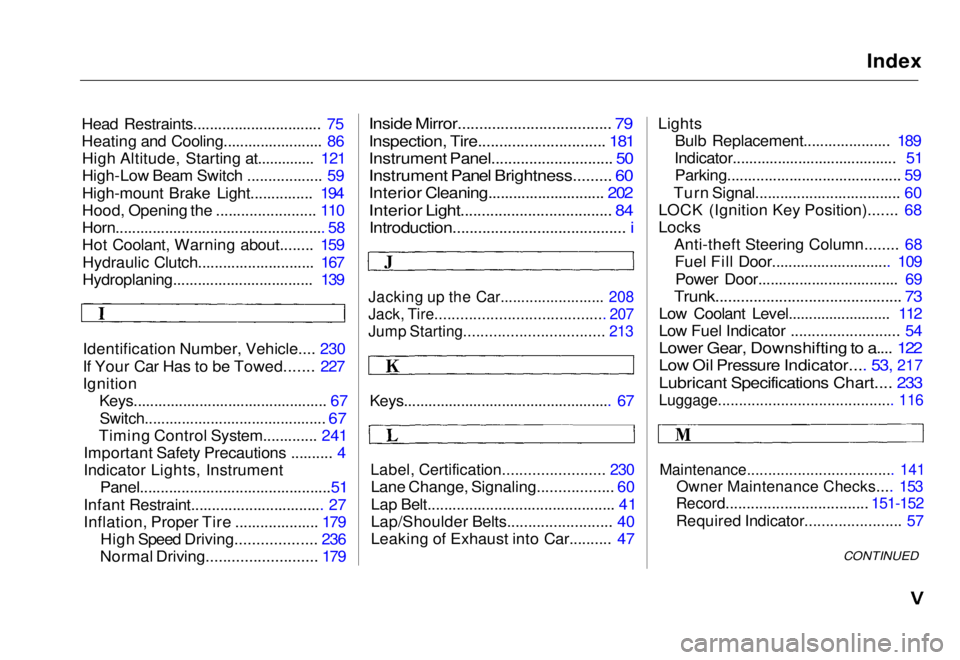inflation pressure HONDA CIVIC COUPE 1998 Owners Manual
[x] Cancel search | Manufacturer: HONDA, Model Year: 1998, Model line: CIVIC COUPE, Model: HONDA CIVIC COUPE 1998Pages: 251, PDF Size: 2.04 MB
Page 142 of 251

Maintenance
This section explains why it is important to keep your vehicle well
maintained and to follow basic
maintenance safety precautions.
This section also includes Maintenance Schedules for normaldriving and severe driving conditions,
a Maintenance Record, and instruc-
tions for simple maintenance tasks
you may want to take care of yourself.
If you have the skills and tools to per-
form more complex maintenance tasks on your Honda, you may want
to purchase the Service Manual. See
page 219 for information on how to obtain a copy, or see your Honda
dealer.
Maintenance Safety....................... 142
Important Safety Precautions.. 143
Maintenance Schedule.................. 144
Maintenance Record..................... 151
Owner Maintenance Checks........ 153
Fluid Locations............................... 154
Engine Oil....................................... 155 Adding Oil................................... 155Recommended Oil..................... 155Synthetic Oil............................... 156
Additives..................................... 156
Changing the Oil and Filter...... 157
Cooling System.............................. 159
Adding Engine Coolant............. 159Replacing Engine Coolant........ 161
Windshield Washers..................... 164
Transmission Fluid........................ 164
Automatic
Transmission.......................... 164
5-speed Manual
Transmission.......................... 166
Brake and Clutch Fluid................. 166
Brake System............................. 167Clutch System............................ 167
Power Steering............................... 168
Air Cleaner Element...................... 169 Spark Plugs..................................... 171
Replacement............................... 171
Specifications............................. 172
Battery............................................ 173
Wiper Blades.................................. 175
Air Conditioning System............... 177 Drive Belts...................................... 178
Timing Belt..................................... 178
Tires................................................ 179 Inflation....................................... 179
Recommended Tire Pressures
for Normal Driving............ 180
Inspection................................... 181
Maintenance............................... 181
Tire Rotation.............................. 182
Replacing Tires and Wheels ....
183
Wheels an d
Tires....................... 184
Winter Driving........................... 184 Snow Tires.............................. 184
Tire Chains............................. 185
Lights.............................................. 186 Headlight Aiming...................... 188
Replacing Bulbs......................... 189
Storing Your Vehicle..................... 197
MaintenanceMain Menu s t
Page 180 of 251

Tires
To safely operate your vehicle, your tires must be the proper type andsize, in good condition with adequate
tread, and correctly inflated. The
following pages give more detailed information on how and when to
check air pressure, how to inspect
your tires for damage and wear, and what to do when your tires need to
be replaced.
Inflation
Keeping the tires properly inflated
provides the best combination of
handling, tread life and riding comfort. Underinflated tires wear
unevenly, adversely affect handling and fuel economy, and are more
likely to fail from being overheated. Overinflated tires can make your
vehicle ride more harshly, are more prone to damage from road hazards,and wear unevenly.
We recommend that you visually check your tires every day. If you
think a tire might be low, check it
immediately with a tire gauge. Use a gauge to measure the air
pressure at least once a month. Even
tires that are in good condition may
lose one to two psi (10 to 20 kPa, 0.1 to 0.2 kgf/cm2) per month.Remember to check the spare tire at
the same time you check all the other tires.
Check the pressure in the tires when
they are cold. This means the vehicle
has been parked for at least three
hours. If you have to drive the
vehicle before checking the tire pressure, the tires can still be
considered "cold" if you drive less
than 1 mile (1.6 km).
CONTINUED
Maintenance
Using tires that are excessively
worn or improperly inflated can
cause a crash in which you can be seriously hurt or killed.
Follow all instructions in this
owner's manual regarding tire
inflation and maintenance.Main Menu Table of Contents s t
Page 206 of 251

Compact Spare Tire
Your vehicle has a compact spare tire that takes up less space. Use this spare tire as a temporary replace-
ment only. Get your regular tire
repaired or replaced and put back on
your vehicle as soon as you can.
Check the inflation pressure of the
compact spare tire every time you
check the other tires. It should be
inflated to:
60 psi (420 kPa , 4.2 kgf/cm2)
Follow these precautions whenever
you are using the compact spare tire:
Do not exceed 50 mph (80 km/h)
under any circumstances.
This tire gives a harsher ride and less traction on some road sur-
faces than the regular tire. Use
greater caution while driving on
this tire.
Do not mount snow chains on the
compact spare.
The wheel of the compact spare tire is designed especially to fit
your vehicle. Do not use your spare tire on another vehicle
unless it is the same make and
model.
The compact spare tire has a shorter
tread life than a regular tire. Replaceit when you can see the tread wear
indicator bars. The replacement should be the same size and design
tire, mounted on the same wheel.
The compact spare tire is not designed to be mounted on a regular
wheel, and the compact wheel is not designed for mounting a regular tire.
Taking Care of the Unexpected INDICATOR LOCATION MARK
TREAD WEAR INDICATOR BARMain Menu Table of Contents s t
Page 251 of 251

Index
Head Restraints............................... 75
Heating and Cooling........................ 86 High Altitude, Starting at.............. 121
High-Low Beam Switch .................. 59
High-mount Brake Light............... 194
Hood, Opening the ........................ 110
Horn................................................... 58
Hot Coolant, Warning about........ 159
Hydraulic Clutch............................ 167
Hydroplaning.................................. 139
Identification Number, Vehicle.... 230
If Your Car Has to be Towed....... 227
Ignition
Keys............................................... 67
Switch............................................ 67
Timing Contro l
System............. 241
Important Safety Precautions .......... 4
Indicator Lights, Instrument
Panel..............................................51
Infant Restraint................................ 27
Inflation, Proper Tire .................... 179 High Speed Driving................... 236
Normal Driving.......................... 179
Inside Mirror.................................... 79
Inspection, Tire.............................. 181
Instrument Panel............................. 50
Instrument Panel Brightness......... 60
Interior Cleaning............................ 202
Interior Light.................................... 84
Introduction......................................... i
Jacking up the Car......................... 208
Jack, Tire........................................ 207
Jump Starting................................. 213
Keys................................................... 67
Label, Certification........................ 230
Lane Change, Signaling.................. 60
Lap Belt............................................. 41
Lap/Shoulder Belts......................... 40
Leaking of Exhaust into Car.......... 47 Lights
Bulb Replacement..................... 189
Indicator........................................ 51 Parking.......................................... 59
Turn Signal................................... 60
LOCK (Ignition Key Position)....... 68
Locks
Anti-theft Steering Column........ 68Fuel Fill Door............................. 109
Power Door.................................. 69
Trunk............................................ 73
Low Coolant Level......................... 112
Low Fuel Indicator .......................... 54
Lower Gear, Downshifting to a.... 122
Low Oil Pressure Indicator.... 53,
217
Lubricant Specification s
Chart.... 233
Luggage.......................................... 116
Maintenance................................... 141
Owner Maintenance Checks.... 153
Record.................................. 151-152
Required Indicator....................... 57
CONTINUEDMain Menu s t